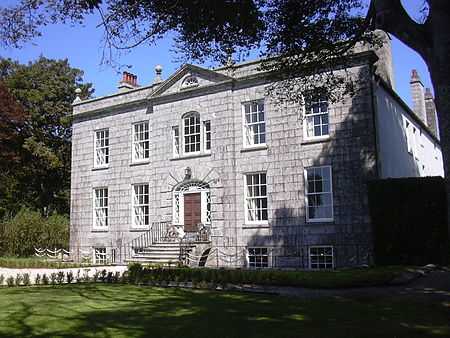Bonython Manor

Bonython Manor near Cury, Cornwall, in the United Kingdom is an estate garden on the Lizard peninsula. Since 1999 the owners have been Mr & Mrs Richard Nathan[1]
Location
It is located five miles (8 km) south of Helston, on the main A3083 Helston to Lizard Road, turn left at Cury Cross Lanes (Wheel Inn) and the entrance is 300 yd (270 m) on the right.
Garden
Magnificent 20-acre (81,000 m2) colour garden including sweeping hydrangea drive to a Georgian manor house (not open to the public). Herbaceous walled garden, potager with vegetables and picking flowers; three lakes in a valley planted with ornamental grasses, perennials and South African flowers; an exotic mysterious quarry lake; traditional rhododendrons, azaleas and many Spring bulbs.
The gardens are promoted by the Campaign to Protect Rural England.[2]
Architecture of house
BONYTHON. Late C18. A delightful granite house of basement and two storeys. Five bays. Eight wide steps with curving handrails rise to the doorway, with fanlight above and wide rusticated surround. The central bay is brought slightly forward. Venetian window above, and a slight pediment with small; fan-shaped window. Four stone balls on hexagonal pillars cap the pediment. Exceptionally elegant.
History
Sir John Langdon Bonython told The Literary Digest: "Bonython is a Cornish name and the accent is on the second syllable: Bon-y'thon, y as in spy. The ancient family located at Bonython in the Lizard district at a very early period. Existing deeds show that Stephen Bonython was in possession of the family lands in 1277."[4] However the family had lived in the area for well over 1,000 years before losing its fortune and Manor in the mid-Victorian era and settling in colonial South Australia. The name Bonython changed phonetically several times over the centuries giving birth to branches with differing spellings, including the historic Donnithorne family of St Agnes which evolved from Bonython over two centuries from c1500.
References
- ↑ The Nathans arrived in 1999: The Cornwall Gardens Guide by Douglas Ellory Pett, pp28-29. Previewed on Google Booksearch (accessed 16 January 2008)
- ↑ Members Guide 2012, published by CPRE, 2012
- ↑ Buildings of England: Cornwall by Nikolaus Pevsner, 2nd edition revised by Enid Radcliffe; Yale 1970 ISBN 0-300-09589-9. page 62 - Article on Cury. These remarks are credited to G.M. Trinick, not Pevsner, himself (Footnote, p 62).
- ↑ Charles Earle Funk, What's the Name, Please?, Funk & Wagnalls, 1936.
External links
| Wikimedia Commons has media related to Bonython Manor. |
Coordinates: 50°02′N 5°13′W / 50.033°N 5.217°W